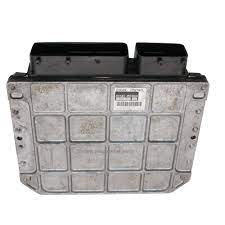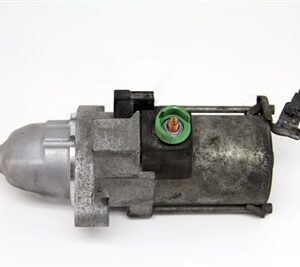Computer Box Engine
Our Computer Box Engine, also recognized as the Engine Control Unit (ECU), stands as the automotive brain, seamlessly overseeing and, to a dynamic extent, regulating vital parameters within the car engine. This sophisticated machine, engineered with precision, epitomizes cutting-edge automotive technology, ensuring optimal performance and efficiency.
Key Features:
- Efficient Monitoring: The computer box diligently monitors critical engine parameters, promoting a harmonious balance between performance and fuel efficiency.
- Adaptive Control: With adaptive control capabilities, the ECU intelligently adjusts settings to accommodate diverse driving conditions, optimizing engine function.
- Diagnostic Prowess: Equipped with advanced diagnostic capabilities, the computer box swiftly identifies and rectifies issues, ensuring the engine operates at peak performance levels.
- Reliable Performance: Crafted with durability in mind, the computer box engine guarantees long-lasting reliability, contributing to the overall longevity of the vehicle.
Unleash the full potential of your vehicle with our Computer Box Engine—a pinnacle of automotive innovation and reliability.
$200.00
CompareComputer Box Engine
The computer box engine, often referred to as the Engine Control Unit (ECU) or Engine Control Module (ECM), is a critical component in modern vehicles. It acts as the brain of the engine, managing and optimizing various engine functions to ensure optimal performance, efficiency, and emissions. The ECU is central to the vehicle’s overall operation and plays a significant role in engine diagnostics and control.
Material and Construction
The computer box engine is housed in a durable, weather-resistant casing designed to protect sensitive electronic components from the harsh conditions under the hood:
- Enclosure: The casing is typically made from high-strength plastics or aluminum alloys, which offer resistance to heat, vibration, and moisture. This ensures the ECU remains functional and reliable even in extreme operating conditions.
- Internal Components: Inside the casing, the ECU contains a printed circuit board (PCB) with various electronic components, including microprocessors, memory chips, and sensors. These components are mounted using advanced soldering and assembly techniques to ensure durability and performance.
- Sealing: The ECU enclosure is often equipped with gaskets or seals to prevent ingress of water, dust, and debris, protecting the internal electronics and ensuring reliable operation.
Design and Functionality
The design of the computer box engine includes several key features and functions:
- Microprocessor: At the core of the ECU is a microprocessor that performs complex calculations and controls various engine functions. It processes data from sensors and makes real-time adjustments to optimize engine performance.
- Sensors and Inputs: The ECU receives input from various sensors located throughout the engine, including those monitoring air-fuel mixture, engine temperature, and exhaust emissions. These sensors provide critical data that the ECU uses to make adjustments and ensure efficient engine operation.
- Actuators and Outputs: Based on sensor data, the ECU sends signals to actuators that control components such as the fuel injectors, ignition system, and throttle body. This precise control helps maintain optimal engine performance and fuel efficiency.
- Communication Interfaces: Modern ECUs often include communication interfaces such as CAN (Controller Area Network) bus systems, which allow the ECU to interact with other vehicle control modules and diagnostic tools. This enables coordinated control of various vehicle systems and facilitates diagnostics and troubleshooting.
Performance and Efficiency
The computer box engine plays a crucial role in optimizing engine performance and efficiency:
- Fuel Management: The ECU manages the fuel injection system to ensure the correct air-fuel ratio for different driving conditions. This helps maximize fuel efficiency and reduce emissions.
- Ignition Control: The ECU controls the timing of the ignition system, ensuring that the spark plugs fire at the optimal moment for efficient combustion. This contributes to smoother engine operation and improved power output.
- Temperature Regulation: By monitoring engine temperature and adjusting parameters accordingly, the ECU helps prevent overheating and ensures the engine operates within its optimal temperature range.
- Emissions Control: The ECU helps manage emissions by adjusting engine parameters to reduce the output of harmful pollutants. It works in conjunction with components such as the catalytic converter and oxygen sensors to comply with emissions regulations.
Maintenance and Diagnostics
Maintaining and diagnosing issues with the computer box engine involves several key practices:
- Software Updates: The ECU’s software may require periodic updates to improve performance, fix bugs, or adapt to new emissions standards. These updates are typically performed using specialized diagnostic tools.
- Diagnostic Scanning: Diagnostic tools can interface with the ECU to read trouble codes and monitor engine parameters. This helps identify issues such as sensor failures, wiring problems, or software glitches.
- Physical Inspection: Although the ECU is designed to be durable, physical inspections may be necessary to check for signs of damage, corrosion, or loose connections. Ensuring that the ECU and its connections are in good condition is crucial for reliable engine operation.
Advanced Engineering and Technologies
Modern computer box engines incorporate advanced technologies to enhance functionality and performance:
- Adaptive Learning: Some ECUs feature adaptive learning algorithms that adjust engine parameters based on driving habits and environmental conditions. This allows for personalized optimization of engine performance.
- Real-Time Data Analysis: Advanced ECUs can analyze real-time data from various sensors to make immediate adjustments to engine functions, improving responsiveness and efficiency.
- Connectivity Features: ECUs in newer vehicles may include connectivity features such as telematics systems, allowing for remote diagnostics, over-the-air updates, and integration with mobile apps.
Conclusion
The computer box engine, or ECU, is a pivotal component in modern vehicles, responsible for managing and optimizing engine functions to ensure performance, efficiency, and emissions control. With its robust construction, sophisticated design, and advanced technologies, the ECU plays a vital role in the vehicle’s operation and maintenance. Regular diagnostics and updates are essential for maintaining its functionality and ensuring the engine operates at its best. As the brain of the engine, the computer box engine contributes significantly to a vehicle’s overall performance and driving experience.
Based on 0 reviews
Be the first to review “Computer Box Engine” Cancel reply
Related products
-
Engine
Flywheel
0 out of 5(0)A flywheel is an essential component in the realm of automotive engineering, serving as a heavy disc affixed to the end of a rotating shaft.
This pivotal device plays a multifaceted role in ensuring optimal engine performance. Firstly, it acts as a reservoir of rotational inertia, imparting stability to your vehicle’s engine by mitigating power pulses.
Moreover, the flywheel meticulously balances the engine, enhancing overall efficiency.
Facilitating the smooth initiation of your engine, the flywheel permits the seamless engagement of an electric starter.
Beyond these technical nuances, the flywheel establishes a critical link between the engine and transmission via a clutch, facilitating the transfer of power to the wheels.
As you consider your automotive needs, rest assured that our flywheel exemplifies precision engineering and reliability, ensuring a harmonious synergy within your vehicle’s intricate mechanics.
Explore the epitome of quality with our Flywheel, a testament to seamless performance and enduring value.
SKU: n/a -
Engine
Harmonic Balancer (Crank Pulley)
0 out of 5(0)The Harmonic Balancer (Crank Pulley) stands as a pivotal component in automotive engineering, seamlessly marrying functionality with precision.
Crafted from a blend of robust metal and resilient rubber, this circular device finds its purpose at the forefront of the crankshaft. Its primary role lies in the adept absorption of vibrations, ensuring a smooth and stable engine performance.
Affixed to the crank pulley, this harmonious union extends its influence to drive essential accessories such as the air conditioner, amplifying its significance in the vehicle’s functionality.
Engineered for optimal efficiency, the internal rubber composition meticulously mitigates vibrations, maintaining an equilibrium that safeguards the engine’s integrity.
The Harmonic Balancer is not just a component; it’s a testament to innovative design and reliability, ensuring your automotive experience remains harmoniously balanced.
SKU: n/a -
Engine
Clutch Master Cylinder
0 out of 5(0)The Clutch Master Cylinder, an integral component of hydraulic clutch systems, plays a pivotal role in transmitting force seamlessly from the clutch pedal to the slave cylinder.
Engineered with precision, this hydraulic marvel operates on a straightforward principle, ensuring optimal performance in every engagement.
The master cylinder, connected to the clutch pedal through a meticulously designed lever mechanism, exemplifies efficiency and reliability.
Crafted for compatibility with a variety of brands, our Clutch Master Cylinder stands as a testament to quality and durability.
Its robust design ensures smooth and responsive clutch operation, enhancing the overall driving experience.
Trust in the seamless functionality of our Clutch Master Cylinder, a key player in hydraulic clutch systems, designed to meet the highest standards of performance and longevity.
Elevate your driving experience with confidence, as our product guarantees precision and reliability across diverse automotive brands.
SKU: n/a -
Engine
Starter
0 out of 5(0)The starter is a vital component in your vehicle’s ignition system, ensuring a smooth and efficient engine start-up.
This compact motor, powered by a reliable battery, plays a crucial role in initiating your car’s operation under its own power. A well-functioning starter is essential for a seamless ignition process.
At the heart of the starter system is the starter relay, strategically positioned between the battery and the starter motor.
This relay efficiently transmits power, ensuring a reliable connection that is integral to the engine’s initiation.
Without a properly operating starter relay and motor, your vehicle may require a tow, leaving you stranded.
Whether you’re considering a replacement or an upgrade, our range of starters, including car starters, remote car starters, and remote start options, guarantees high performance and durability.
Trust in our starters to provide the reliability your vehicle deserves, ensuring a prompt and efficient start every time. Elevate your driving experience with our cutting-edge starter solutions.
SKU: n/a -
Engine
Timing Chain
0 out of 5(0)Introducing our Precision Timing Chain, a vital component meticulously designed to synchronize the intricate dance between the crankshaft and camshaft(s) in your engine.
Crafted for optimal precision, this timing chain ensures seamless coordination, guaranteeing accurate timing for the precise opening and closing of engine valves during each cylinder’s firing cycle.
Built to withstand the rigors of engine dynamics, our timing chain boasts durability that exceeds industry standards.
Engineered for longevity, it operates within the heart of your engine, requiring periodic oil maintenance to ensure peak performance.
When it comes to reliability and efficiency, our timing chain stands as the epitome of excellence.
Experience the epitome of timing precision with our Timing Chain, a testament to engineering ingenuity. Our commitment is to deliver unrivaled performance, setting the benchmark for quality and durability in every rotation.
SKU: n/a









There are no reviews yet.